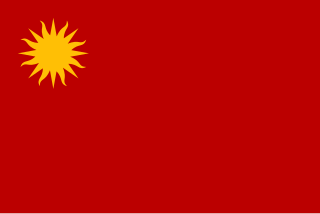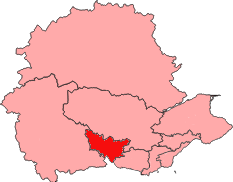Related Research Articles

Stirling is a city in central Scotland, 26 miles (42 km) northeast of Glasgow and 37 miles (60 km) north-west of Edinburgh. The market town, surrounded by rich farmland, grew up connecting the royal citadel, the medieval old town with its merchants and tradesmen, the Old Bridge and the port. Located on the River Forth, Stirling is the administrative centre for the Stirling council area, and is traditionally the county town of Stirlingshire. Proverbially it is the strategically important "Gateway to the Highlands". It has been said that "Stirling, like a huge brooch clasps Highlands and Lowlands together". Similarly "he who holds Stirling, holds Scotland" is sometimes attributed to Robert the Bruce. Stirling's key position as the lowest bridging point of the River Forth before it broadens towards the Firth of Forth made it a focal point for travel north or south.

The Stirling council area is one of the 32 council areas of Scotland, and has a population of about 92,530. It was created in 1975 as a lower-tier district within the Central region. The district covered parts of the historic counties of Stirlingshire and Perthshire, which were abolished for local government purposes. In 1996 the Central region was abolished and Stirling Council took over all local government functions within the area.

The Colorado Party is a liberal political party in Uruguay.

The Division of Stirling was an Australian electoral division in the inner northern and beachside suburbs of Perth, Western Australia, which included a large portion of the local government area of the City of Stirling.

Stirling was a county constituency of the House of Commons of the Parliament of the United Kingdom. It elected one Member of Parliament (MP) by the first past the post system of election.
Stirling and Falkirk Burghs was a parliamentary constituency represented in the House of Commons of the Parliament of the United Kingdom from 1918, comprising the burghs of Stirling, Falkirk and Grangemouth. It ceased to be a District of Burghs in 1950, but a constituency of the same name covering the same burghs continued in existence. In 1974 it became Stirling, Falkirk and Grangemouth. This was in turn abolished in 1983; it was the last British constituency to consist of non-contiguous parts.
West Stirlingshire was a county constituency of the House of Commons of the Parliament of the United Kingdom, to which it elected one Member of Parliament (MP) by the first past the post electoral system.

Stirling is a constituency of the Scottish Parliament (Holyrood) covering part of the council area of Stirling. It elects one Member of the Scottish Parliament (MSP) by the plurality method of election. It is one of nine constituencies in the Mid Scotland and Fife electoral region, which elects seven additional members, in addition to the nine constituency MSPs, to produce a form of proportional representation for the region as a whole.
Stirling Burghs was a district of burghs constituency of the House of Commons of the Parliament of the United Kingdom from 1708 to 1918.
Stirling was an electoral district of the Legislative Assembly in the Australian state of Western Australia from 1950 to 2008.

The 1998 California Attorney General election occurred on November 3, 1998. The primary elections took place on June 3, 1998. The Democratic nominee, Bill Lockyer, defeated the Republican nominee, Dave Stirling, for the office previously held by incumbent Dan Lungren, who chose not to seek re-election in favor of running for governor.
Blackwood-Stirling was an electoral district of the Legislative Assembly in the Australian state of Western Australia. It took parts of the South West and Great Southern regions of Western Australia.

Stirling James Hinchliffe, is an Australian politician.
Elections to Stirling Council were held on 3 May 2007, the same day as the other Scottish local government elections and the Scottish Parliament general election. The election was the first one using seven new wards created as a result of the Local Governance (Scotland) Act 2004. Each ward elected three or four councillors using the single transferable vote system form of proportional representation. The new wards replaced 22 single-member wards which used the plurality system of election.

Clackmannanshire and Dunblane is a constituency of the Scottish Parliament (Holyrood) covering part of the Stirling council area and the entirety of Clackmannanshire. It elects one Member of the Scottish Parliament (MSP) by the plurality method of election. It is one of nine constituencies in the Mid Scotland and Fife electoral region, which elects seven additional members, in addition to the nine constituency MSPs, to produce a form of proportional representation for the region as a whole. Created in 2011, the constituency covers much of the area previously in the abolished Ochil constituency.
Elections to Stirling Council were held on 3 May 2012, the same day as the 31 other local authorities in Scotland. The election used the seven wards created under the Local Governance (Scotland) Act 2004, with 22 councillors being elected. Each ward will elect either three or four members, using the STV electoral system.

Steven Alexander Paterson is a former Scottish National Party (SNP) politician who served as the Member of Parliament (MP) for Stirling between 2015 and 2017. He was not re-selected by the SNP to contest the Stirling seat at the 2019 general election.

Stephen Charles Kerr is a Scottish Conservative & Unionist politician, currently serving as a Member of the Scottish Parliament for Central Scotland Region since 2021. From 2021 to 2022, Kerr served as the Convener of the Education, Children and Young People Committee. Prior to his election to Holyrood, Kerr was the Member of Parliament for Stirling from 2017 to 2019.

Evelyn Tweed is a Scottish politician who has been the Member of the Scottish Parliament (MSP) for Stirling since 2021. A member of the Scottish National Party (SNP), she was a councillor in Stirling for Trossachs and Teith ward from 2017 to 2022.

2022 Elections to Stirling Council were held on 5 May 2022, the same day as the 31 other local authorities in Scotland. The election used the seven wards created under the Local Governance (Scotland) Act 2004, with 23 councillors being elected. Each ward elected either 3 or 4 members, using the STV electoral system.